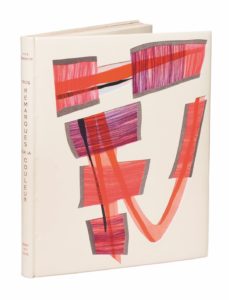
The Wittockiana’s collection of book bindings is and remains a collection put together by a bibliophile in accordance with his own tastes. Thus, it is no surprise that the collection does not represent an exhaustive history of bookbinding.
In the world of art, the constitution of a private collection frequently differs from that of a public museum’s by the divergent outlooks that exist between the simple lover of beauty and the scientifically rigorous historian. The collection of artistic book bindings that Michel Wittock assembled over some forty years makes no claim to represent the entire history of bookbinding through the ages or throughout the world. More drawn to Latin culture than Germanic, Wittock was naturally more interested in the development of artistic styles in Italy, at first, and then in France. He did not set great store by the conventional selection criteria coming from museums, but instead, having chosen to acquire objects which he appreciated for their beauty alone, he developed an interest in the gold, and sometimes silver, ornamentation of the Renaissance.
Having had a chance to first interest himself with Italian book bindings of the first half of the 16th century, still soberly decorated, he came to realize that the art of binding and ornamenting a book could, like any other decorative art, be legitimately considered as an art in its own right, just like architecture, painting or sculpture, which until the 19th century had wrongly been regarded as the only “real” arts. Swept away by this new passion for books, he very soon extended the scope of his interest to French book bindings of the High Renaissance, the exuberantly diverse decoration of which provide an insight into the fascinating intellectual life of well-to-do book collectors. After becoming acquainted with the different styles of bookbinding in France over the centuries, Wittock eventually discovered a new passion: contemporary bookbinding…
The collection of book bindings held in the Wittockiana thus provides a vast panorama of the development of ornamental bookbinding, from the gilded bindings of the Renaissance to the avant-garde creations of today, with a particular emphasis on the work of modern and contemporary decorative bookbinders in France and Belgium.
As such, it is possible to follow the evolution of bindings created by artistic bookbinders (also known as “original” bindings), from the introduction of floral ornamentation during the Art Nouveau movement, through to influences from Art Deco and other artistic, aesthetic and literary movements then in vogue such as cubism, futurism, dadaism, constructivism and surrealism.
Nowadays the stylistic emphasis is on abstraction. Sometimes, this is in the lyrical expression offered by a multiplicity of materials (box calf, reptile skins, precious woods, metal, rubber, plastic, polycarbonate etc.), sometimes seen in the internal structure, made visible, and thus becoming part of the decoration itself. In reality, the ingenuity is without limit, the possibilities are so vast. An ornamental book binding can now claim its status, so rarely accorded in the past, that of an original work of art.

